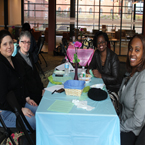Thinking Outside of the [Shoe]Box Women and Christ Class Takes Creative Approach to Analyzing and Addressing Gender Issues
April 19, 2015
 Dr. Virginia Wiles, NBTS Professor of New Testament, was faced with a dilemma: how to teach an evening course at the Seminary when her doctors advised her not to drive at night. The solution? A new learning experience and a new approach to thinking outside of the box.
Dr. Virginia Wiles, NBTS Professor of New Testament, was faced with a dilemma: how to teach an evening course at the Seminary when her doctors advised her not to drive at night. The solution? A new learning experience and a new approach to thinking outside of the box.
The course, Women and Christ, is new to the Seminary’s curriculum. It examines how gender affects a person’s understanding of Christ and how Christ finds “feet” in the world – particularly the feet of women. Critical gender theory and New Testament theology (as well as the students’ own experiences) are used in order to better understand the relationship of women and Christ in our world.
“I was trying to work out a schedule that would accommodate my disabilities better than a regular evening course,” explained Dr. Wiles. “I decided to have a retreat when classes were not in session, then continue to work with the students throughout the spring semester.”
In January, Dr. Wiles and 17 students traveled to the Community of St. John Baptist, a convent located in Mendham, New Jersey. For an entire weekend, the class lived, supped and studied together, and were given the opportunity participate in the convent’s prayer services. “For many of our students, it was the first time they had witnessed the “Praying of the Hours,” said Dr. Wiles.
The purpose of the retreat was not simply to enjoy the peace and quiet reflection offered by the convent’s secluded surroundings; the students were asked to view the world from a different perspective, to question what they observe and to think outside of the box – the shoebox, that is.
The Shoebox Method, created by Dr. Wiles, is a means of collecting, organizing, assessing and interpreting information. The process helps each student form a habit of observation, to think more creatively, to honor her own thoughts and to get information out of her head and “onto the page” (or into the shoebox), all in a way that is unique to each student.
During the retreat, the students used the Shoebox Method to collectively develop two critical questions to ask about gender. The group settled on the following: 1) What gender assumptions lie behind what I’m seeing or hearing, and would the message change if I changed the gender?; and 2) How is what I’m seeing or hearing being used to damage women? “These are critical questions students can raise in everyday life& when they see a commercial, have a conversation, read a book or talk to a family member,” stated Dr. Wiles.
To put the method into practice, each student was tasked with reading one of four books on feminist theory (specifically related to Christianity and the New Testament) selected by Dr. Wiles, as well as one written by a man on New Testament theology. The students were divided into groups of four and then asked to pose those questions to the male Christology. Dr. Wiles stressed that the point was not to attack the book written by the male author, but to help the students learn how to ask critical gender questions about a text that doesn’t raise those questions.
Fresh from the mountain top experience of the retreat, the students returned to the Seminary to organize World Cafés and worship services for the NBTS community. The World Cafés addressed issues of human trafficking, how women do and should express power (and how that changes in Seminary), domestic violence and how the church has used scripture to silence women’s voices. The chapel services also highlighted gender; the hymns were changed to use female pronouns when referencing God, and prayers incorporated female imagery.
The Women and Christ class imparted more than knowledge. The experience created a strong bond and sense of community between the students as well. One student shared with Dr. Wiles that prior to this class, the student didn’t feel she had a connection with the Seminary. Now, after meeting “some great ladies at the retreat,” the student feels connected and credits Dr. Wiles with stirring her “learning and creativity to give my all the second time around.”
“This clearly worked,” reflected Dr. Wiles. “I think the success of courses is directly related to the retreat. It was a wonderful way to kick off the semester, and it allowed the students to actively work together in conjunction with the traditional lecture format.”
Armed with more discerning eyes and ears, it is Dr. Wiles’ hope that her students will take their critical gender questions with them to other classes. “The ability to perceive gender dynamics (power and privilege) is developed over time. We must be patient with one another, honor our differences with integrity and always be willing to keep growing in our perception and in our action.”
